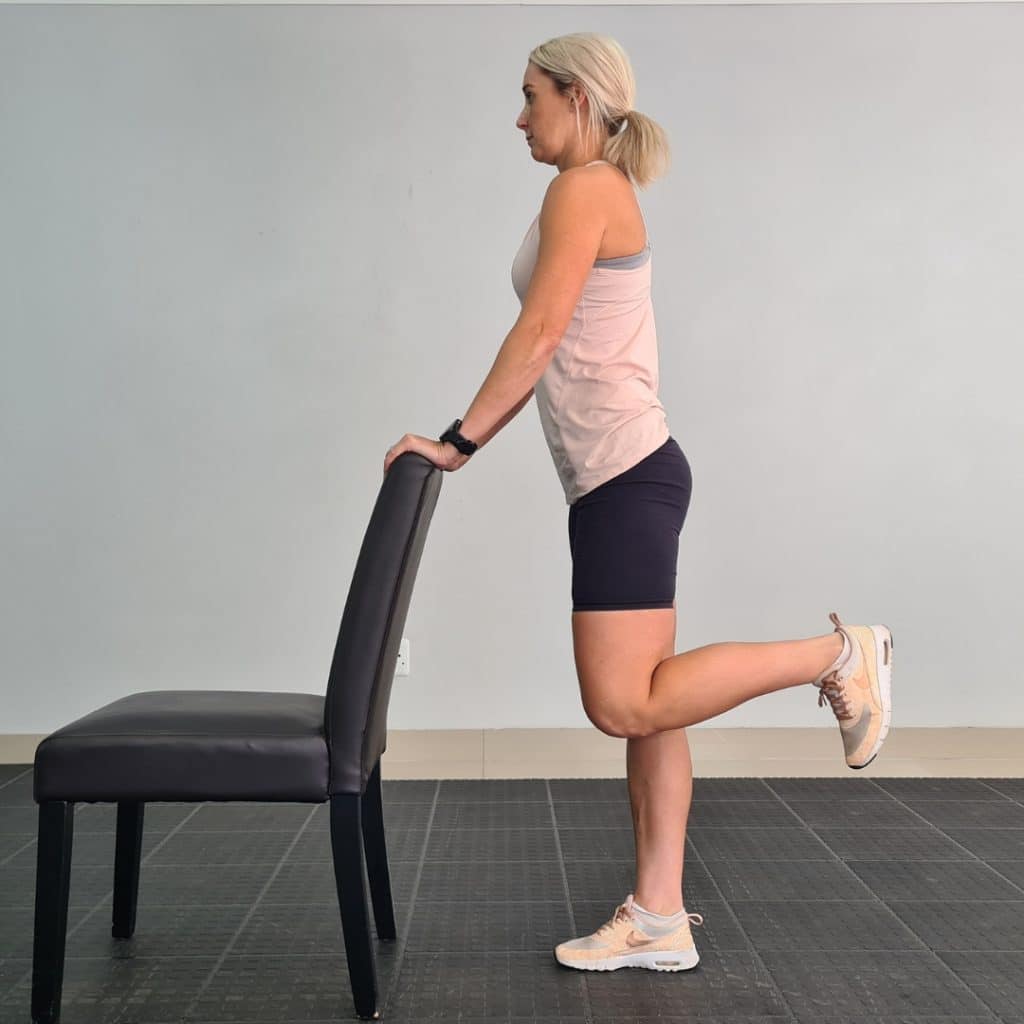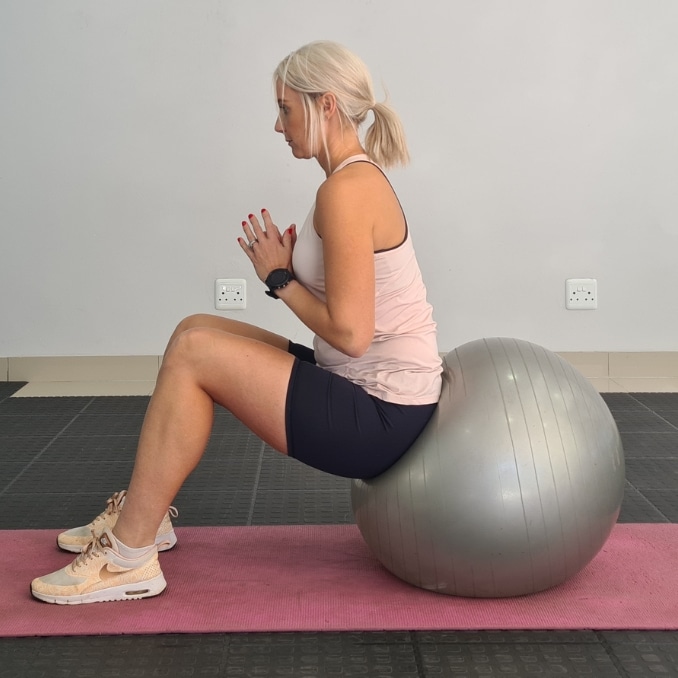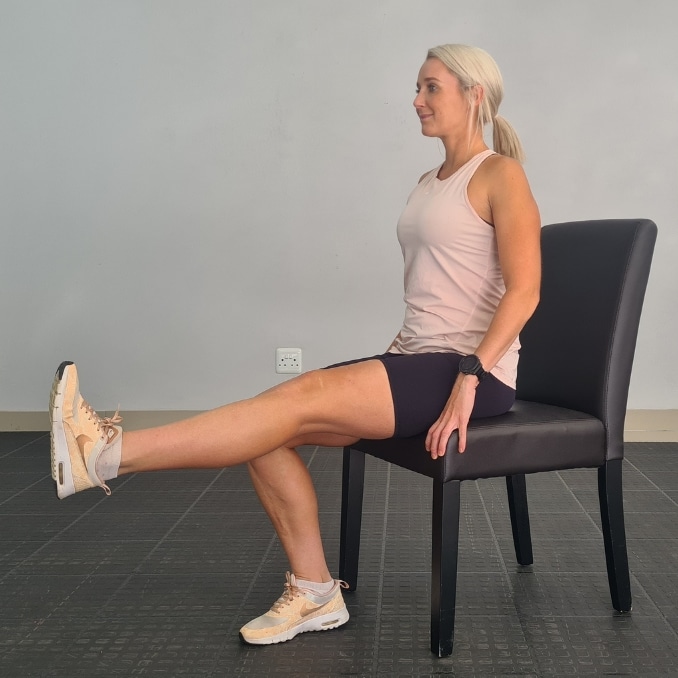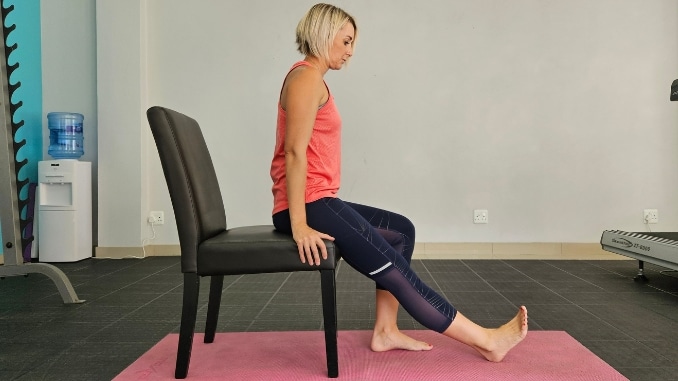Are you tired of feeling discomfort every time you take a step? Do you wish you had stronger knees to support your daily activities? We’ve got you covered.
In this article, we will share quick and easy exercises to strengthen knees to help you regain stability and mobility in your knees. We believe that everyone deserves to move with confidence and ease. That’s why we have curated this exercise collection specifically targeting the muscles surrounding your knees.
Take the first step towards stronger knees today! Join us as we guide you through these simple yet effective knee-strengthening exercises.
Best Knee Exercises for Knee Pain
Incorporating a well-rounded exercise routine targeting key muscle groups around the knee can enhance strength, flexibility, and resilience. Here are some effective knee-strengthening exercises:
1. Standing Knee Flexion
You can use a wall, a couch, or a bench to support this exercise.
Begin in an upright standing position behind a wall with your feet hip-width apart, maintaining good alignment of your head, shoulders, hips, and legs. Slowly bend your left knee backward and keep your left foot flat on the wall, ideally at a 90-degree angle. Put your hands on your hips and engage your core. Lift your left heel off the wall and slowly drop your heel down, squeezing your glutes. After a few repetitions, return to the starting position and repeat the movement. Complete 2 to 3 sets of 5 repetitions on each side.
 |  |
2. Standing Hamstring Stretch
For this exercises, you can use a chair for balance.
Begin in an upright standing position in front of a chair with your feet hip-width apart, maintaining good alignment of your head, shoulders, hips, and legs. Place both hands on the back of the chair. Engage your core and bend your left leg backward, ideally at a 90-degree angle. Hold the position for a couple of seconds. Then, lower your foot and repeat the movement on the opposite leg.

3. Seated Double Leg Raise to Knee Flexion
For this exercises to strengthen knees, you can use a resistance band for added resistance and a chair for support.
Begin in an upright sitting position on a chair with your knees bent and feet flat on the floor, maintaining good alignment of your head, shoulders, and hips. Wrap a resistance band around your feet. Place your hands on the side for support and engage your core. Raise both legs forward and then lower one foot to the floor, creating resistance to the band. Slowly raise back up to return to the starting position. Repeat the movement on the opposite side.
 |  |
Alternative Exercise: Hamstring Rollers with Stability Ball
For this exercise, you can use the stability ball, rolling chair, or anything that will allow you to move during the Exercise.
Begin in an upright sitting position on the stability ball with your knees bent and feet flat on the floor, maintaining good alignment of your head, shoulders, and hips. Tighten your core and press your heels against the floor as you push your legs straight, rolling the ball backward. Roll back in to return to the starting position and repeat the movement as needed.
 |  |
4. Seated Leg Extension
For this exercise, you can use a chair for support.
Begin in an upright sitting position on a chair with your knees bent and feet flat on the floor, maintaining good alignment of your head, shoulders, and hips. Place your hands on your side. Engage your core, slowly straighten one foot forward, and lift it ideally at hip height, keeping your toes pointed upward. Return to the starting position and repeat the movement on the other side.
 |  |
5. Seated Straight Leg Raise
For this exercise, you can use a chair for support.
Begin in an upright sitting position on a chair with your knees bent and feet flat on the floor. Maintain good alignment of your head, shoulders, and hips. Keep one leg bent as you straighten your other leg with your heel on the floor. Engage your core and lift your other leg at hip height, keeping your toes pointed forward. Hold the position for a few seconds and return to the starting position. Repeat the movement on the opposite side.
You can lift your leg at hip height and bend your knee towards your chest for an added challenge. You can also point your toes out to the sides or inwards for a deeper stretch on your quads.
 |
 |
6. Semi-Squat
For this exercises to strengthen knees, you can use a chair for support.
Begin in an upright standing position in front of a chair with your feet shoulder-width apart, maintaining good alignment of your head, shoulders, hips, and legs. Place both hands on the backrest of the chair and tighten your abdominal muscles. With your knees bent, hinge your hips to bring your upper body forward, moving into a semi-squat position. Raise back to the standing position Repeat the movement. Start off with 1 set of 6 to 10 repetitions.
You can lower your squat for a deeper stretch in your glutes and mid-back for an extra challenge.

Before you jump into the specific exercises, it’s essential to understand the key principles that should guide your knee-strengthening routine.
Incorporating Exercises to Strengthen Knees into Your Fitness Routine
Incorporating exercises to strengthen knees into your fitness routine promotes joint health[1], prevents injuries, and enhances overall lower body strength. Here are some tips on how to do so:
1. Warm-up
Before performing knee-strengthening exercises, it’s important to warm up[2] your muscles and joints. Spend a few minutes doing light cardio exercises like jogging or cycling to increase blood flow and prepare your body for the workout.
2. Mix it up
Incorporate a variety of exercises to strengthen knees into your routine. By targeting different muscle groups and using different movement patterns, you can ensure that you are strengthening your knees from all angles.
3. Rest and recover
Allow your body time to rest and recover between knee-strengthening sessions. This will give your muscles time to repair and grow stronger. If you experience any muscle soreness, pain, or discomfort during or after the exercises, take a break and consult with a healthcare professional.
4. Seek professional guidance
If you’re unsure about the proper form or technique for any exercise, consider seeking guidance from a certified fitness professional or physical therapist. They can provide personalized advice and ensure you perform the exercises correctly and safely.
Remember to prioritize safety, be mindful of your body’s signals, and enjoy the benefits of improved knee health and overall well-being.
Conclusion
Prioritizing knee health is integral to overall well-being and maintaining an active lifestyle. The knee joint plays a crucial role in daily movements, and addressing its strength, stability, and flexibility is essential for preventing injuries and promoting longevity. Incorporating a balanced combination of knee-strengthening exercises, flexibility routines, and proper biomechanics into your fitness regimen contributes to optimal joint function.
Regular assessment of your knee health, consulting with healthcare professionals when needed, and listening to your body’s cues are key components of a proactive approach. Utilizing a holistic and individualized strategy can cultivate strong, resilient knees that support mobility, enhance your quality of life, and contribute to your lifelong fitness journey.
Is knee pain or knee weakness stopping you from doing the things you love… or the basic daily tasks and movements you need to do? Check out this 10 Easy Movements for Stronger Knees!


